Pathology services in Dorset have been through significant transformations, including the new-build pathology hub on the Bournemouth site. Director for One Dorset Pathology Stephen Harding talks us through the journey.
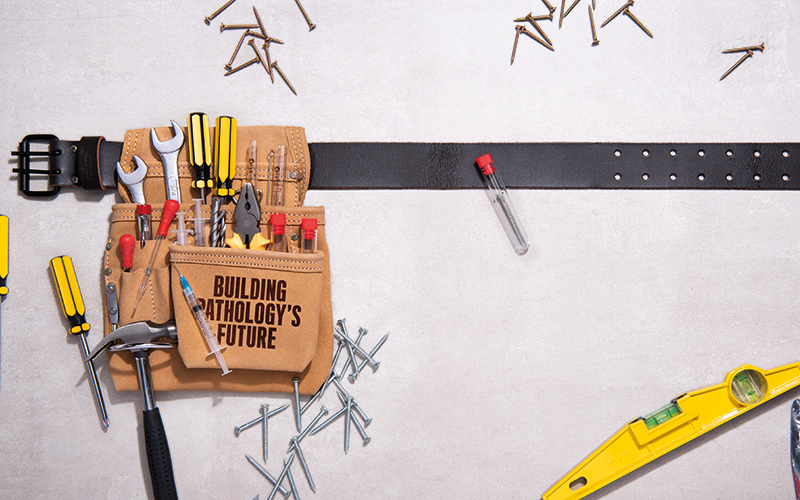
Pathology services, and the best way to provide pathology, has been subject to many reviews over the years. The provision of pathology within Dorset has been no exception to this and in 2015 the Vanguard programme sought to enhance and align a number of clinical and supporting services across Dorset. This led to the formation in 2017 of One Dorset Pathology.
The remit of One Dorset Pathology was, and still is, to bring together the pathology services within Dorset to give an integrated pathology service, providing clinicians, patients and carers with timely diagnostic information to help them make informed decisions while continually refining the operational model to meet evolving clinical needs, maximise efficient use of resources and enable staff to develop to their full potential and work to deliver continuous service improvement.
Such complex transformations take a significant amount of time in planning and execution. It was two years of planning and assessment to take plans through the strategic, outline and finally full business case approval by the trust boards.
Outside influences
As the Greek philosopher Heraclitus once said, the only constant is change. With a long-running transformation such as this many external factors influence and may change the direction of travel. The first to impact on this programme was the 2017 letter setting out the intent to form 29 pathology networks within England. This made it clear that the changes in Dorset would need to align with and enable changes throughout the wider South 6 network. This led to the adjustment of plans to ensure that they were scalable and able to fit in with an, as of yet, undecided operating model for the wider network. This was followed by the merger of two of the acute trusts, Poole and Bournemouth, with the consequential diversion of time and planning to ensuring this was implemented effectively. Then came the outcome of a Dorset-wide clinical services review, which proposed the transformation of Royal Bournemouth Hospital into a major acute site with Poole Hospital becoming a planned site. Lastly, the plan to build a new theatre block mainly within the footprint of pathology on the Poole site led to an additional reconfiguration.
Each of these led to a review of the proposal for pathology within Dorset to ensure that these remained aligned to the requirements. The final configuration was the formation of a major processing hub on the Bournemouth site to support the upcoming major acute centre.
A first-pass processing model, where samples are received, stabilised and have their basic tests performed outside the hub, was agreed for the other sites – all this to be supported by a single management structure.
“There were many steps that needed to be taken before the ground could be broken”
The enablers
The huge range and impact of pathology services can be overwhelming when looking to make a radical difference to the service provision at a multi-trust level. Early reviews that looked at the choice of making changes on a discipline-by-discipline and department-by-department level were discounted as unlikely to deliver the best foundation for the future pathology services. However, to bring all the services together required huge changes in all areas, ranging from equipment to IT systems and management teams. Also physical buildings needed changes to harmonise practice to move towards a single service.
The first, and probably most difficult, change was the move to a single LIMS for all of the then three trusts. This had to be flexible enough to meet the different clinical needs across Dorset and be expandable enough to roll out to another five trusts in the future. This was followed by the replacement and harmonisation of equipment.
The pathology transport services had evolved over many years to include non-pathology items, such as pharmacy, patient notes, and a postal service. It was a significant amount of work to unpick this and produce a specification to tender for a new service.
The space
The space required to support the desired operating model was quite easy to assess but the estates model, where this space would be located and how the different elements would interact, was the part of the transformation that was most agonised over. Before the outcome of the clinical services review was known, many options for the provision of the centralised services were contemplated and assessed. These included whether each site could be supported through an essential services laboratory, whether the hub should be multiple hubs with one for each discipline, and whether the hub, or hubs, should be located on the main hospital sites or moved to a brownfield site.
Early in the decision process, the subject matter expert (SME) representatives for each of the teams went on site visits to the pre-existing pathology networks. Their remit was to shamelessly steal any ideas that worked well, or as many put it, learning from best practice. The 10 key criteria for consideration were IT, interconnectivity, clinical need, quality, staffing, resilience, cost, accessibility, available space and transport/logistical implications. The highest weighting was given to clinical need, then cost and staffing. This led to the decision that all sites should have a local laboratory with enough capacity to meet the site clinical need and that the hub should be a single hub for all disciplines, where possible, and that this hub should be co-located with one of the main hospital site as to do otherwise would lead to an additional local laboratory in order to process the more urgent samples produced by that site.
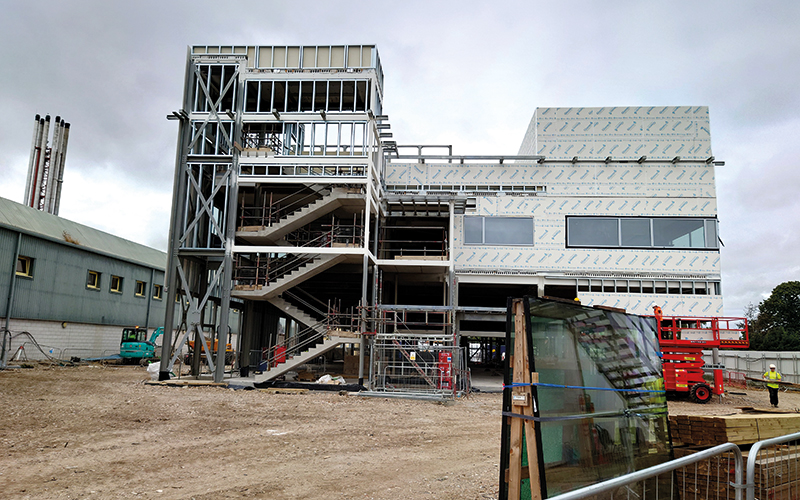
As the decisions were coming to a head, the clinical services review announced the formation of an acute/planned site split for the East of Dorset with a blended acute/planned site for the West. This would come into effect from 2025 and as the majority of the urgent and inpatient work comes from patients whose condition would place them on the acute site, this galvanised the decision to locate the hub on the acute site designate. However, the need to increase the bed space within the acute site and the fact that the current pathology footprint was in a prime location that would be needed for this increase in bed provision led to the need for a new build rather than the more common refurbishment and adaptation of current labs. Only once all this was in place could the work on the design of the new pathology hub start.
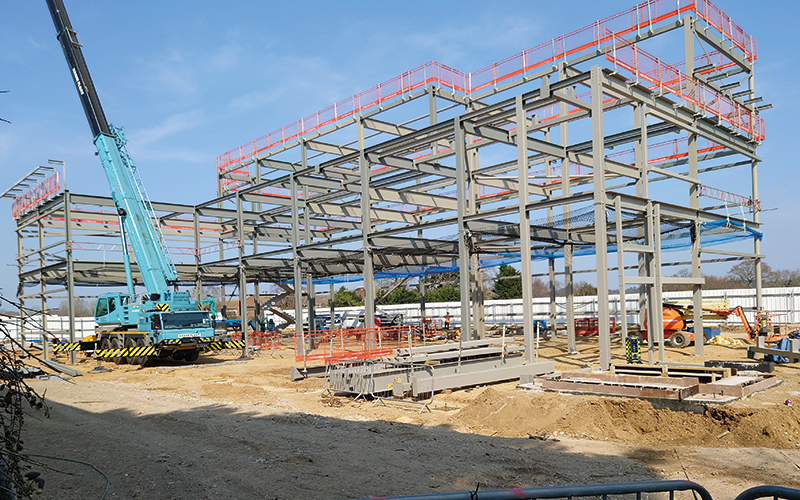
Planning to build
There were many steps that needed to be taken before the ground could be broken and building commenced in earnest. The first of these was to identify the site of the new build. We knew the rough size of the facility from the current footprint of the services we were looking to host in the hub, and we knew it would have to be a new build as none of the existing buildings on the Bournemouth site were suitable or available to reconfigure into a pathology hub. As with the vast majority of hospital sites, spare space was scarce within the current campus. However, the Bournemouth site does benefit from open, unused space around it and the trusts decided that expanding the campus would fit in with its current needs and future plans. This gave the space we needed for the new laboratory while maintaining the crucial links, such as access to pneumatic air tubes for sample transport and the ability to continue to support blood transfusion requirements within the hospital site.
With this in place, the design team got to work on the more detailed plans for the hub. This in itself took three phases. The initial phase tested the space-requirement assumptions made previously by working closely with the laboratory leads to ensure that all the equipment and processes could be accommodated within the allocated space whilst removing any inefficient processes and unnecessary equipment for each discipline. This took several iterations before we were happy to move to the second phase.
The next phase was to engage a project management team and interim architects to take the high-level or 1 in 200 plans from the first phase through the more detailed planning phase. These worked through more detailed designs showing an estimate of where each room would be within the overall design. This design phase was underpinned by the lessons learned from site visits and other recent pathology reconfigurations while maintaining the flexibility we would likely need to meet future changes in demand. To this end, we decided on a two-floor build. The main, ground floor laboratory was to be an open-plan space housing all disciplines other than cellular pathology, which would have its own space on the first floor. These designs were then used to tender for the main architects who would take us through the rest of the process. Before releasing the designs for tender the trust undertook a value-engineering exercise with an independent team stress testing the plans and challenging the teams with the remit of reducing the footprint and associated costs where possible. Additional funding was granted from the local enterprise partnership who felt that the new build links with research and the local university were in line with their strategic goals.
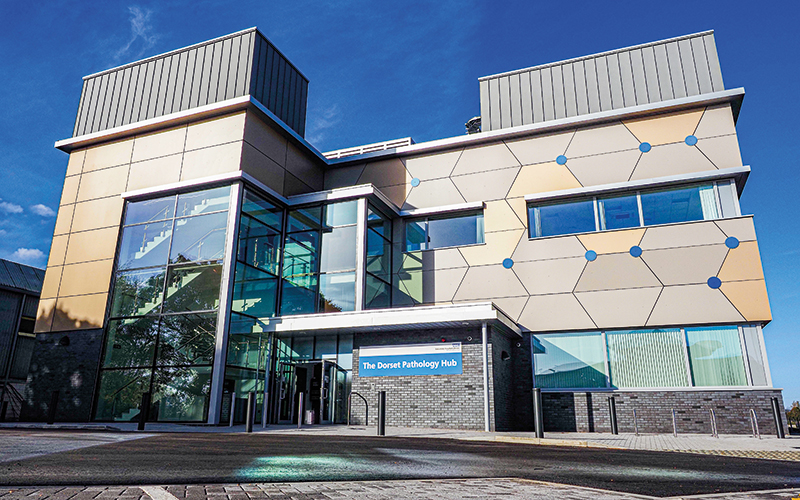
“We wanted to ensure that the building was able to adapt to changes in the years to come”
Pathology is undergoing a period of significant change and we wanted to ensure that the building was not only fit for the model of pathology services now, but also able to adapt to any changes in the years to come and be able to support the pathology services of the future. To this end, flexibility was a key driver in the design process. Working with the team and taking lessons from other pathology builds we opted for an open-plan layout housing biochemistry, haematology, blood transfusion, molecular, and microbiology. This is supported by a matrix of underfloor service that will help with any future reconfigurations.
Ethical and social values played a significant part in the design process. This being a new build we had the opportunity to push for more sustainable solutions wherever possible. The brief was to achieve a Building Research Establishment Environmental Assessment Methodology (BREEAM) rating of excellent. This led us to use heat pumps for heating and cooling with a significant solar panel array on the roof and the most effective insulation and air handling we could use.
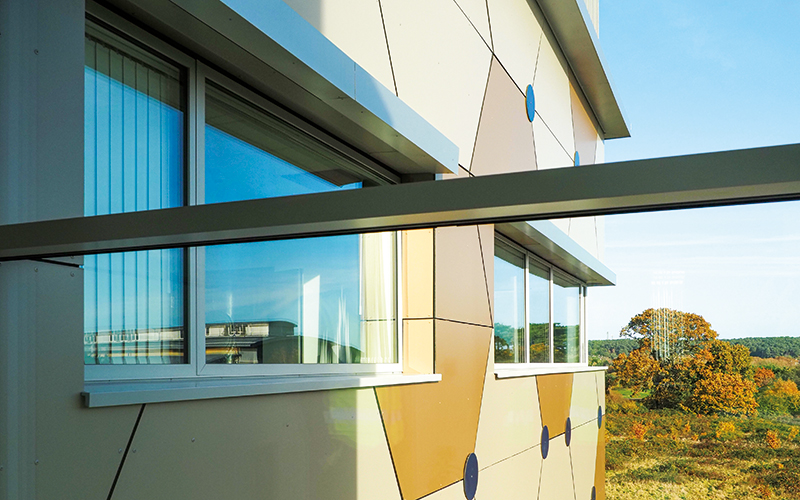
We were now ready for the third phase, which started with the tender for the team of architects who would take us through the more detailed, 1 in 100, and then very detailed, 1 in 50, designs. Once the architects were in place, we could build the rest of the team. This included, among others, specialist services contractors, IT specialists, and the equipment providers. Only then could we do the work to produce the plans with enough detail to allow us to tender for a build partner and apply for full planning permission. Obtaining planning permission takes quite some time and inevitably leads to some changes to the plans, thankfully no major changes in our case, just changes to the colour scheme and moving of the bicycle store before we had the plans approved. We were encouraged to buy many of the building materials in advance. This included the steel frame, windows, doors, and many other elements that we could safely buy and store in advance in order to minimise delays and costs associated with the build. This was very serendipitous as the international steel shortage led to a massive increase in prices shortly afterwards.
The building
Once the tender process was complete and our building partners were selected, we could actually start the build. We broke ground in January 2022. There was then a two-month gap between the start and any visible signs of the build while all the groundworks and drains were put in place. By March the steel frame was up and the building was starting to take shape. Then the floors were delivered; each of the two tonne “planks” had to be craned into place before the shell of the building could be fitted in August.
The next 12 months saw the work to turn the shell into a fully functional building. This included a huge amount of infrastructure and plant. By July we could see the internal space taking shape and the building was handed over to the trust in November 2023.
As with any new build, there is a period of snagging and fettling. Currently, services are moving into the hub on a discipline-by-discipline basis.
The amount of work needed to move a service and validate equipment/processes is enormous. This will take us through to April 2024 or six months before the hub will be fully functional.
It has been a huge privilege to lead on such a large transformation project, the success of which is testament to the dedication of the teams within the labs.
A new build has significantly more complexities than a refurb and we would not have got here without the support from our colleagues in other departments, who often went the extra mile. My advice to anyone embarking on such a project would be to spend as long as possible on the planning stage, ensure the right project team is in place and consistently engage with the SMEs both within and outside pathology. Avoid delays whenever possible as building inflation will eat away at the funding at a disturbingly rapid rate.
Next steps
As I mentioned before, the only constant is change and there will be a review of the service provision on each site as the planned/acute split comes into effect. The service may also have to adapt to the changing needs as the wider South 6/Southern Counties Pathology model takes shape.
Image credit | Supplied
